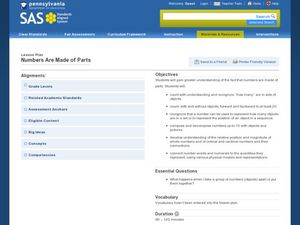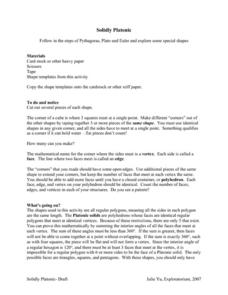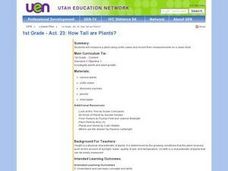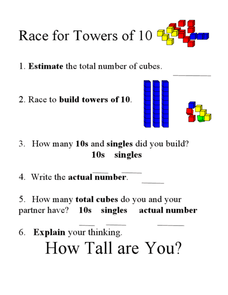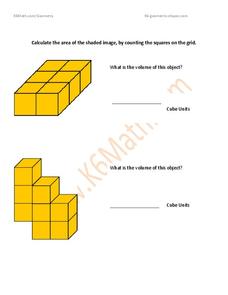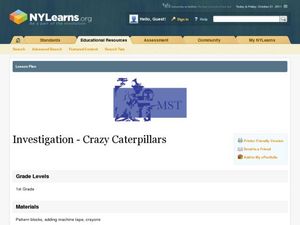Fuel the Brain
Brain Boosters - Add Ten on a Number Line
Encourage learners to use pictures, numbers, or words to solve two-word problems in which they count by 10's using a number line. They tell the total number of items the child has in each problem by starting at a given number and adding...
Curated OER
Sampling Rocks
Students collect and sort rocks based on visible characteristics. In this statistics lesson, students determine adequate sample size and categorize rocks based on characteristics. The book Everybody Needs a Rock is read to...
Utah Education Network (UEN)
Linear Relationships: Tables, Equations, and Graphs
Pupils explore the concept of linear relationships. They discuss real-world examples of independent and dependent relationships. In addition, they use tables, graphs, and equations to represent linear relationships. They also use ordered...
Pennsylvania Department of Education
Numbers Are Made of Parts
Children play with barnyard animal cards to practice composing and decomposing numbers. With their "secret number" of animal cards in a cup, they shake and spill them onto a barn story board, counting how many animals fall in the barn...
Curated OER
Measurement (Grades 3-5)
Third, fourth, and fifth graders participate in measurement centers. They visit six different centers: standard and linear measurement, clocks, weight, volume, temperature, and converting measurements. They complete a data collection...
Curated OER
Probability and Applications of Simulations
Middle schoolers apply properties of probability to the real world. In this probability instructional activity, learners simulate the construction of empirical distribution. They collect and analyze data using central tendencies.
Curated OER
Dice that Go Up to Numbers Less than Six
Print, cut, and fold this pair of large die. Intended for an Autistic or special needs class, these dice include numbers 1-3 and won't add up to more than 6. This is a great way to engage a child socially as well as academically.
Curated OER
Solidly Platonic
When they do, they learn. Using this resource, young mathematicians learn about platonic solids by actually building, touching, and examining the shapes. They connect their observations about the shapes to Euler's formula.
National Council of Teachers of Mathematics
The Roll Out Fractions Game: Comparing Fractions
Reinforce the concept of comparing fractions with a hands-on, two-player game that calls for a visual model, score board, and dice. Players roll dice to acquire their given fraction, create the fraction using fraction tiles, then...
Curated OER
Domino Practice
Students are given organizing boards and play domino and cube games. These simple games provide fun and practice in categorizing, using dominos and unifix cubes.
Curated OER
Rolling Records
Fourth graders play a game to determine the likelihoods of different outcomes when rolling two number cubes. Students play a game to determine the likelihoods of different outcomes when rolling two number cubes.
Curated OER
Counting On
In this math instructional activity, students practice addition of one digit numbers and adding on addition. Students start with one set, then add more. Example: Gus Plus has 5 cubes. He collects 8 more. He now has----. There are 18...
Curated OER
Tens and Ones
In this counting by groups worksheet, students practice counting by tens and then by ones. Students count the rows of ten and single cubes and then write how many cubes there are all together.
Curated OER
Linus Minus
For this math worksheet, learners practice one digit subtraction from one or two digits. Students complete 6 word problems and 12 horizontal subtraction problems.
Curated OER
Numeracy Practice- Going Out For Lunch
In this math instructional activity, students complete the various types of activities that include graphs, data tables, and completing number sentences.
Curated OER
How Tall are Plants?
First graders measure a plant using unifix cubes and record their measurements on a class chart.
Curated OER
How Much Gift Wrap Do I Need?
Students estimate the area of boxes using centimeter cubes. They find the actual area and compare it to the estimates.
Curated OER
Towers of 10
Students complete four worksheets of activities to use cubes to count by 10s. For this counting blocks lesson, students use blocks to count by 10s and complete block counting activities.
Curated OER
Which Word Matches the Image? #2
In this math worksheet, students learn to match the name of a geometric figure with the picture. Students examine a drawing of a geometric shape, then circle the word that matches it.
Curated OER
Discovering Solids
Second graders engage in a lesson that is about the discovery of solids. They identify using shapes like cones, spheres, cylinders, and cubes in various different situations. Students explore the classroom in order to find examples of...
Curated OER
Groups of Ten Tens
In this place value worksheet, students read about counting by tens using rows of cubes. They circle groups of 10 rows and write how many hundreds they make.
Curated OER
Calculate Area Using Shaded Grids
In this area worksheet, students calculate area of shapes using shaded grids, writing answers in cube units. A reference web site is given for additional activities.
Curated OER
Investigation: Crazy Caterpillars
First graders explore biology patterns by creating a model insect. In this patterns lesson, 1st graders utilize snap cubes and pattern blocks to recreate their own version of a centipede or caterpillar. Students create their caterpillars...





